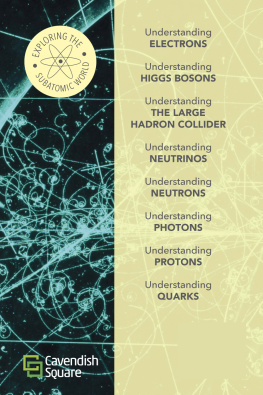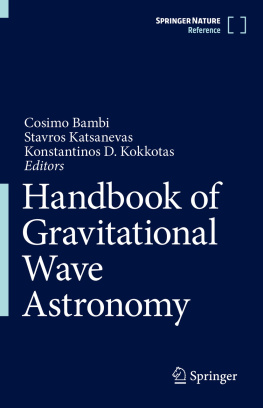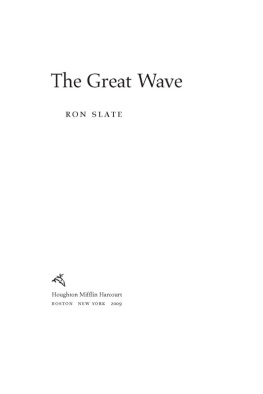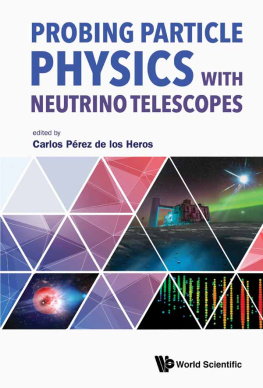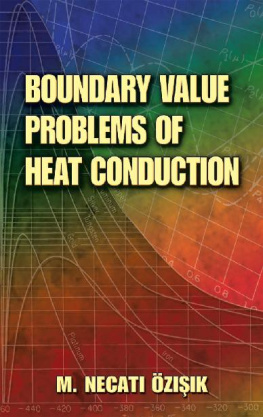Pas - The perfect wave: with neutrinos at the boundary of space and time
Here you can read online Pas - The perfect wave: with neutrinos at the boundary of space and time full text of the book (entire story) in english for free. Download pdf and epub, get meaning, cover and reviews about this ebook. City: Cambridge;Mass;London;England, year: 2014, publisher: Harvard University Press, genre: Art. Description of the work, (preface) as well as reviews are available. Best literature library LitArk.com created for fans of good reading and offers a wide selection of genres:
Romance novel
Science fiction
Adventure
Detective
Science
History
Home and family
Prose
Art
Politics
Computer
Non-fiction
Religion
Business
Children
Humor
Choose a favorite category and find really read worthwhile books. Enjoy immersion in the world of imagination, feel the emotions of the characters or learn something new for yourself, make an fascinating discovery.

The perfect wave: with neutrinos at the boundary of space and time: summary, description and annotation
We offer to read an annotation, description, summary or preface (depends on what the author of the book "The perfect wave: with neutrinos at the boundary of space and time" wrote himself). If you haven't found the necessary information about the book — write in the comments, we will try to find it.
Pas: author's other books
Who wrote The perfect wave: with neutrinos at the boundary of space and time? Find out the surname, the name of the author of the book and a list of all author's works by series.
The perfect wave: with neutrinos at the boundary of space and time — read online for free the complete book (whole text) full work
Below is the text of the book, divided by pages. System saving the place of the last page read, allows you to conveniently read the book "The perfect wave: with neutrinos at the boundary of space and time" online for free, without having to search again every time where you left off. Put a bookmark, and you can go to the page where you finished reading at any time.
Font size:
Interval:
Bookmark:
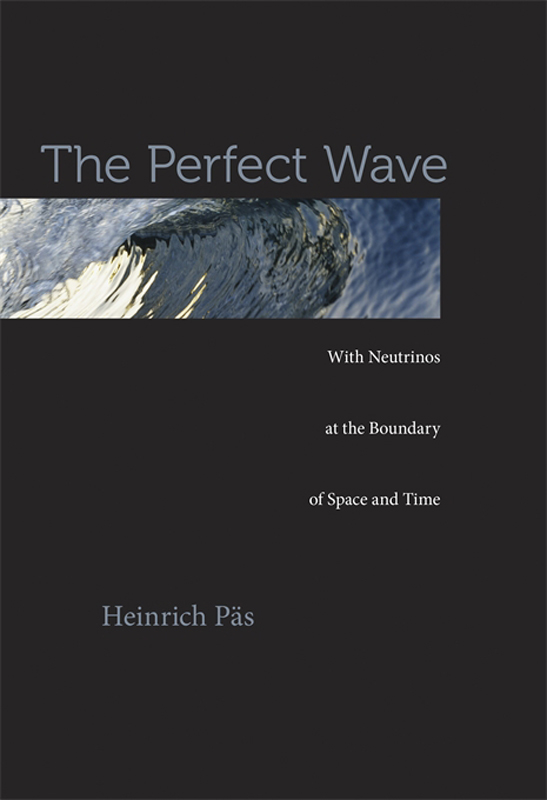
The Perfect Wave
The Perfect Wave
With Neutrinos at the Boundary of Space and Time
HEINRICH PS

Harvard University Press
Cambridge, Massachusetts
London, England
2014
Copyright 2014 by the President and Fellows of Harvard College
All rights reserved
An earlier version of this work was first published as Die perfekte Welle: Mit Neutrinos an die Grenzen von Raum und Zeit , copyright 2011 by Piper Verlag GmbH, Mnchen.
Jacket design: Tim Jones
Jacket photograph: Patrick Trefz/Getty Images
The Library of Congress has cataloged the printed edition as follows:
Ps, H. (Heinrich)
The perfect wave : with neutrinos at the boundary of space and time / Heinrich Ps.
pages cm
Includes bibliographical references and index.
ISBN 978-0-674-72501-0 (alk. paper)
1. Particles (Nuclear physics)History. 2. NeutrinosMass. 3. Cosmology. 4. Space and time. I. Title.
QC793.16.P37 2014
539.7'215dc23 2013025630
To my father, who inspired in me the curiosity for the things beyond the horizon, and the love of nature.
To my mother, who inspired in me the love of beautyand of books.
Contents
Warning up front! This book deals with established scientific insights and with wild speculations. There is motivation, even justification, for the speculations, but they are neither proven nor confirmed by experiment. While much of the established science itself can sound crazy when first encountered, I highly recommend that the reader be alert to this difference.
Well, all I can say is that at times truth is stranger than fiction.
V IKAS S WARUP , Slumdog Millionaire
Of the topics treated within this book, quantum physics in experimentally. Shortcuts in extra dimensions are speculations squared, and time travel in extra dimensions is a speculation well, at least to the power of three, but many established physicists consider it rather as speculation to the power of 1,000. On the other hand, physics has always been full of surprises and apparent paradoxes: Simultaneity depends on the observer, rigid causality no longer exists, and clocks run more slowly when one is in motion. It is not at all impossible that the physics of time travel will be just as baffling.
Scientific speculations are great fun, but they are more than that. They are an integral part of science itself; they guarantee that science can actually progress. Naturally, such speculations require a critical mind that examines carefully what one dares to believe, what one wants to analyze more accurately, and what one is ready to discard as unlikely. But if one wants to capture science in its actual liveliness and fascination, one cannot refrain from giving speculations at least a little bit of coverage.
The wild ideas of yesterday quickly become todays dogma.
S HELDON G LASHOW , Winner of the Nobel Prize in Physics, 1979
Like Proust be an old teahead of time.
Jack Kerouac, Belief and Technique for Modern Prose
As a postdoc you have the craziest job in the world.
You get your PhD with honors at one of the best universities, and at the same time they kick you out. You apply everywhere in the world, and you have not the faintest clue on which continent or in which time zone you will end up. Then you get a new job at a different university, and you can come and go whenever you want and do whatever you want. You can just think about the most esoteric questions that come to your mind: What is all matter made of? What is happening at the beginning and at the end of the universe? What is time? All that is required is that you write down whatever insights you gain and publish them in scientific journals. Until two years later and irrespective of how good you werethen you get kicked out again, and the whole story repeats itself.
This was the reason I was standing, on this February mornings dawn, on a beach on the other side of the world. With my Danish friend Ketil I stared, shivering, into Waikikis surf, rolling in from the endless Pacific (of us brought himself to push his board into the water and started to paddle out toward the break, while the sun slowly climbed over the rim of Diamond Head crater.

Figure 1.1. View over Waikiki to Diamond Head crater. (Courtesy Ullstein Bild/Prisma/Steve Vidler)
Surfing in Hawaii ranks somewhere between national sport and religionan active ceremony honoring the Hawaiian god Lono. What is most impressive for me about surfing, though, is the suddenness of the experience. In the beginning the water is often totally glassy, but after paddling out for a few hundred meters you reach the reef. Bathed in the first sunlight, a tiny fluctuation created by a storm thousands of miles away growsas if caused by magicinto a wave. Soon the wave transmutes into an impressive greenish blue wall, a wall thatif after many failed tries, with tired arms and a headache, you manage to catchaccelerates you breathlessly and throws you into an ocean of adrenaline as it breaks into a carpet of snow-colored whitewater.
Physics ideas are like the Hawaiian surf. They seem to come from nowhere, they catch you suddenly without warning, and they draw you into an exhilarating trip. Later, on such days, I would sit in seminars daydreaming of breaking waves, or I would wander restlessly over the Manoa campus of the University of Hawaii, gazing at the cliffs overgrown by rain forest, while my brain untangled a clutter of film clips of the surf and thoughts about my present physics project. On one of these afternoons the following thought occurred to me: Assume that our universe, with its three space and one time dimension is embedded in a larger space with many extra dimensions. Our universe, lying there like the carpet in your living room. Could this carpet buckle? Assume further that there are elementary particles that can propagate not only in our common 3 + 1 dimensions but in the whole extra-dimensional space. Could these particlesinstead of following the carpet bucklestake a shortcut along the floor? Could they make a duck dive, like a surfer diving underneath an incoming wave while paddling out? Could they in this way be faster than everything moving along the bumpy surface? How would it look, then, for an observer on the carpet, or the ocean-surface universe, if these particles traveled even faster than light? Could they actuallyaccording to a well-known paradox in Einsteins relativitytravel back in time?
At first glance, any single part of this idea seems crazy. Why should the universe have more than three space dimensions? And even if there were reasons, where in the world should these extra dimensions be? Whats the nature of these exotic elementary particles? And why should our universe have even the slightest similarity to a buckled carpet or the surface of the Pacific Ocean on a winter day? Why should something that moves faster than light be able to travel backward in time? How could this be possible at all?
This is all part of a long story, whose beginnings date back more than 3,000 years to ancient Greece. A story that continued in the 1920s at Europes universities, and has been augmented by science fiction and recent experiments at the most advanced laboratories for elementary-particle physicsCERN in Geneva, Switzerland, and Fermilab near Chicago. A true story that at times resembles a mystery thriller, with secret cults, dead philosophers, mind-expanding drugs, the mysterious disappearance of brilliant scientists, subterranean research labs, and experiments in Antarctica. It is a story of an elementary particle that, just like the Silver Surfer in the superhero cartoons, surfs to the boundaries of knowledge, of the universe, and of time itself. A story that captivates you as it sucks you into a maelstrom like an oversized wonderland.
Font size:
Interval:
Bookmark:
Similar books «The perfect wave: with neutrinos at the boundary of space and time»
Look at similar books to The perfect wave: with neutrinos at the boundary of space and time. We have selected literature similar in name and meaning in the hope of providing readers with more options to find new, interesting, not yet read works.
Discussion, reviews of the book The perfect wave: with neutrinos at the boundary of space and time and just readers' own opinions. Leave your comments, write what you think about the work, its meaning or the main characters. Specify what exactly you liked and what you didn't like, and why you think so.



